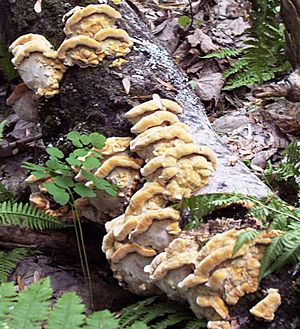Inonotus cuticularis facts for kids
Quick facts for kids Inonotus cuticularis |
|
|---|---|
 |
|
| Scientific classification | |
| Genus: |
Inonotus
|
| Species: |
cuticularis
|
| Synonyms | |
|
Boletus cuticularis Bull. (1790) |
|
Inonotus cuticularis is a type of fungus that often grows on trees. It belongs to a group of fungi called Hymenochaetaceae. This fungus is known as a plant pathogen, which means it can cause diseases in plants, especially trees.
Contents
About Inonotus cuticularis
Inonotus cuticularis is a fascinating fungus. It was first described in 1790 by a scientist named Bull. Later, in 1879, another scientist named P. Karsten gave it its current scientific name. Like many fungi, it has had a few different names over the years as scientists learned more about it.
Where Inonotus cuticularis Lives
This fungus has a very wide distribution, meaning it can be found in many places around the world. It lives in what scientists call the "circumpolar distribution." This means it's found in the northern parts of the world, circling the globe.
You can find Inonotus cuticularis in the temperate zone. This zone includes areas with moderate climates, not too hot and not too cold. For example, it grows in the eastern parts of the U.S. and Canada. It also lives across Asia, in countries like Japan, China, and Russia. You can also find it in central Europe.
What Inonotus cuticularis Does
As a plant pathogen, Inonotus cuticularis plays a role in nature by affecting trees. It often grows on dead or dying wood, helping to break it down. This process is important for recycling nutrients in forests. While it can cause disease, it's also part of the natural cycle of life and decay in ecosystems.
See also
 In Spanish: Inonotus cuticularis para niños
In Spanish: Inonotus cuticularis para niños

